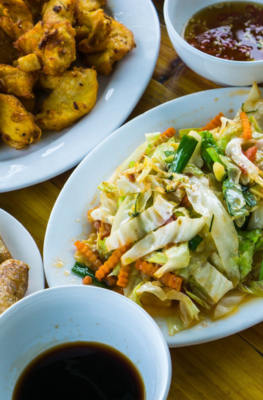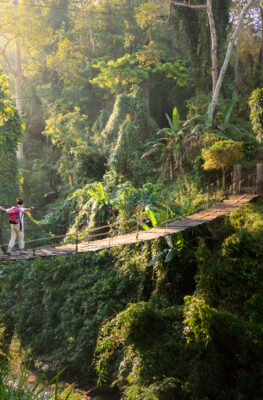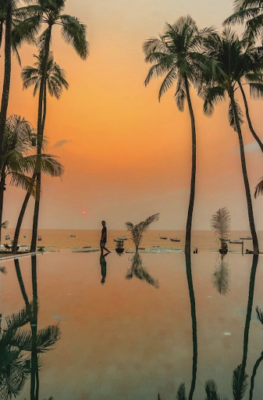Published on September 11, 2017
Vinpearl Golf Resort, Vietnam. Image © Albedo20/Creative Commons
You think of beaches, culture, and street food first when Southeast Asia comes up in conversation. But for a growing number of travelers to the region, golf has become a significant reason to invest time and money traveling here.
“Southeast Asia is one of the most exciting and fastest-growing golf destinations on the planet,” explains Becky Gee, a freelance golf writer and resident blogger at the Nomadic Golfer. “With fantastic weather, great food, and some awesome courses, there’s really little not to love.”
What, exactly, draws avid golfers to Southeast Asia? We talked to a couple of golfing travel bloggers to give us the lowdown:
Affordability. Golf-mad travel blogger Drew “Binsky” Goldberg zeroes in on the relatively low cost of golfing in Southeast Asia: “The courses are on par (no pun intended) with the most beautiful courses around the world – and it’s about half the price here to golf.”
Drew estimates that, at “about $20-30” for Southeast Asia greens fees compared to upward of $100 for an average course in Arizona, USA, where he hails from, Southeast Asia is a “fantastic” deal: “Almost four times as cheap, and you get a caddy too, which is awesome.”
The caddy factor. Local caddies are easy to come by on Southeast Asia’s greens, says Drew. “Growing up I never had caddies, ever – first time ever having a caddy was in Asia,” Drew tells us. “And they’re actually mandatory on many courses; you don’t even get a choice.”
Becky calls the easy availability of caddies “the biggest perk of playing in Southeast Asia…. those found in Thailand are often regarded as the world’s finest.” Speaking from her own experience teeing off in Thailand, Becky recalls that most of the caddies she worked with were female (“it’s very rare to find a male caddie,” she says).
Gorgeous, challenging courses. The luxury end of Southeast Asia’s golf courses rival the best you’ll find in Europe and North America. Top names in golf have a hand in designing courses throughout the region, many set amidst some of the area’s most beautiful landscapes.
“Many of the best courses are designed in an American-style, with plenty of water hazards and big imposing bunkers,” Becky informs us. “Recent years have seen the emergence of some fantastic links courses, particularly in Vietnam.”
For her money, Becky swears by the Els Club Teluk Datai in Langkawi, Malaysia – “an outstanding course,” she recalls. “Golfers must drive over mountains and dense jungle to reach the course, which then carves its way through the rainforest before reaching the shores of the Andaman Sea. It’s hard to overstate just how spectacular the views are.”
Drew spent a couple of weeks golfing through Vietnam’s top courses, and came away with a clear favorite: “There’s one called Sacom Tuyen Lam Golf Resort,” Drew tells us. “With amazing conditions in Da Lat; beautiful nature around, with mountains, there’s zero flaws.”
The luxury stay attached to the Sacom Tuyen Lam sealed the deal for Drew. “A five-star resort, right on the course – you wake up and go get out and play,” Drew tells us. “And it had good wifi, which is not easy to come by in Vietnam!”
Els Club Teluk Datai, Langkawi, Malaysia. Image © Tourism Malaysia.
Where to Tee Off in Southeast Asia
Becky sees a bright future for golf travel in Southeast Asia – even off the beaten path, in countries not normally known for their world-class courses.
“Thailand is now among the most popular countries for golf tourists, while the opening of some world-class courses in Vietnam, Malaysia, and Cambodia means that other areas of the region are now following suit and developing their own golf infrastructure,” Becky says.
Both Becky and Drew have a few up-and-coming golf countries in their crosshairs:
Thailand. “Thailand without a doubt has the best infrastructure, with tons of fantastic courses,” Becky tells us. “In my experience, the Thai hospitality is just a step above anything else, whether that be in Southeast Asia or any other region.”
Malaysia. With luxury courses in Kuala Lumpur and further afield, Malaysia’s golf experience comes tied up with its gorgeous surroundings. “The best thing is skipping from the golf course straight to the beach,” Becky recalls of her experience teeing off in Langkawi.
- For a travel package that combines the best golf courses in Malaysia and Thailand, check out the Footsteps of the Masters Grand Golf Tour.
Vietnam. Drew counts over 300 courses played all over the world in his lifetime, but he puts Vietnam right at the top of his list. “I went from North to South [in Vietnam], playing the finest courses,” Drew tells us. “They’re all really green, with really vibrant colors. The countryside is really fantastic. Vietnam is very mountainous; so you get these incredible views all around.”
Cambodia. “The Cambodian golf scene is still in its fledgling stages,” Becky explains. “For tourists heading to Angkor Wat, there are a couple of fantastic courses in Siem Reap that are more than worth a visit.”
Myanmar. It’s not famous for its golf courses – which piques Drew’s curiosity even more. “First off, that country is amazing, I love the people and the culture,” Drew tells us. “Second, you don’t know what to expect. Everybody knows what golf in Thailand looks like, but Myanmar, it’s more off the beaten path.”
Blue Canyon Golf Course, Phuket, Thailand. Image courtesy of Tourism Authority of Thailand.
How to Get the Most Out of Your Golf Trip
Bring plenty of water. Unlike courses in the West, Southeast Asia’s country clubs mainly know only two types of weather: hot and wet. “The biggest obstacle to playing golf in Southeast Asia, at least for me, is the heat,” Becky confides. “The first time I played in Malaysia we stupidly went out in the afternoon, and finished after nine holes, absolutely drowning in sweat. Lesson learnt.”
Mind the language gap. Drew recalls a language barrier between himself and his caddies in Vietnam. “If you’re going to Vietnam, you’re already going to get lost in the language,” Drew says. “They know words like left, right, downhill, uphill. If I’m a putting green, they point to where I should aim, they ‘ll say, ‘wind’; just by knowing very few key words in English, you can communicate whatever you want.”
Look beyond the course. Many of the region’s top golf courses lie within striking range of their respective country’s top tourist sites. Becky counsels golfers to take advantage of the location. “I’ve always had an unquenchable thirst for travel and love to play golf and explore what else the area’s destinations can offer,” she tells us. “I think the area and facilities outside the course would be high in my priorities.”
Unique hazard: wildlife. Golfers in more out-of-the-way locations should be wary of the local animals. Becky knows this first-hand, at least in Langkawi. “Beware of having your buggy hijacked by monkeys – this is quite a common occurrence, and they show no qualms in rummaging through your golf bags!” she tells us.
* * * *
To find out where Becky Gee tees off next, follow her adventures at www.thenomadicgolfer.com, or follow her on social media: Facebook, Twitter and Instagram.
To check out Drew Binsky‘s continuing adventures on and off the greens, visit his website at drewbinsky.com, or follow him on social media: Facebook, Snapchat, Instagram and Twitter.






